Content outlines are essential to creating effective and engaging content. Not only it makes the task of crafting a content piece easier, but also ensures that the content has a logical consistent flow and an increased chance of ranking highly on search engine results.
I have personally outlined 2 – 3 pieces of content per week for the past 2 years and it’s been immensely helpful in streamlining the overall content creation process.
I have learned a lot along the way, and today I want to share some of my tips for creating effective content outlines. I will also include some examples, as well as a template that you can use to get started.
Just click on each section to learn more:
- What is a Content Outline?
- Why is it Important to Use a Content Outline?
- How to Create a Content Outline
- Using a Content Outline Template
- Examples of Content Outlines
- Streamline Work With Content Outlines
What is a Content Outline?
A content outline is like a table of contents of the content piece. It provides a clear structure and organization of the content by listing out the main topics, subtopics, and points that you want to discuss in your content.
A typical content outline would list out each section with an appropriate heading and subheadings (H2s, H3s, H4s, etc.) that summarizes what the content in each section is about.
Notes and bullet points can also be added to further describe the content within each section.
Furthermore, a brief description of the topic, target audience, search intent, and a call to action statement can be included in the content outline or be a part of a larger content brief.
Why is it Important to Use a Content Outline?
You should always create a content outline before writing your content.
Here are the five main reasons why:
- Helps keep content on topic and well-organized. A content outline helps to keep the focus on the stated topic, as well as ensure that it is organized in a logical manner. This makes it easier for readers to browse through your content quickly and find what they are looking for.
- Allows you to create high-quality content faster. With an effective content outline, people working on creating the content know exactly what needs to be written and how to structure it. This can help speed up the writing process, as there’s no need to worry about coming up with ideas on the spot.
- Helps avoid writer’s block. The outline serves as a blueprint for the content piece and can help avoid writer’s block. It gives the confidence to start creating content and finish the content with ease.
- Increases the odds of ranking highly on search engines like Google. Search engines like content that is structured, organized and satisfies the search intent of the user. Using a content outline allows you to create content that ticks all these boxes and stands a better chance of ranking highly.
- Allows you to scale up content creation. A well-structured outline makes it easier for other content creators to follow and replicate the same style. Freelance writers, content agencies, or even a team of in-house writers can use the same format and style to create high-quality content.
How to Create a Content Outline
Now that you know why it’s important to create a content outline, let’s look at how you can go about creating one.
1. Determine the Topic and Target Keyword
The first and most crucial step is to decide on the topic and identify a target keyword.
I know this is basic, but it’s always important to ensure that the content you create is in line with your target audience’s interests, and business goals and that you have the potential to rank for the desired target keyword.
Ideally, you would already have your entire content plan laid out. In this case, you would just pick the topic and the keyword you want to target, plug it into the document, and continue with the next steps.
But if you don’t have a content plan, then do some brainstorming about potential topics. As well as find the keywords related to the.
Then, choose to target the main one with the highest search volume, which does not have too many competitors covering the topic and your site has the potential for ranking well.
2. Research Users Search Intent
Next, highly important, is to analyze the users’ search intent.
Understanding and serving the user intent should be the focus of any content you create. As this is what search engines like Google use to determine whether your content is relevant or not.
There are four main types of search intent:
- Informational – when someone searches for content to learn more about a topic
- Navigational – when people want to find a specific page on a website
- Commercial – when users are looking for information before making a purchase
- Transactional – when someone searches with the intent to purchase a product or service
Your content should fall into one of these categories.
To further dissect the search intent, you can try and answer the following questions:
- Is there a user need or problem that needs to be addressed? What it is?
- What sort of content does the user expect to find when searching for this keyword?
- What kind of content do other websites rank for this keyword?
You can then move on to the next step to choose the perfect combination of the content type, format, and angle to create content that will satisfy the user’s search intent.
3. Decide on the Content Type, Format, and Angle
I recommend using the framework of the 3 C’s (content type, content format, content angle), which I first found when reading an article by Ahrefs on how to determine the search intent.
They recommend using this framework to optimize content for the user intent.
Here is how it works:
- Content Type. This includes the general type of content you should create. For example, a blog post, product page, product category page, infographic, video, perhaps a combination of more than one type, etc.
- Content Format. This is the format of the content you are going to create, such as a list post, a how-to guide, an expanded definition post, a landing page featuring a tool or quiz, etc.
- Content Angle. This is the unique angle or perspective you take to address the topic at hand which will make your content stand out from the competition. Think about your content’s unique selling proposition.
I have created a Google Doc which includes the most common ones, plus some real-life examples, for you to use as inspiration.
It’s free to access, just head to the link and make a copy of it: get Google Document.
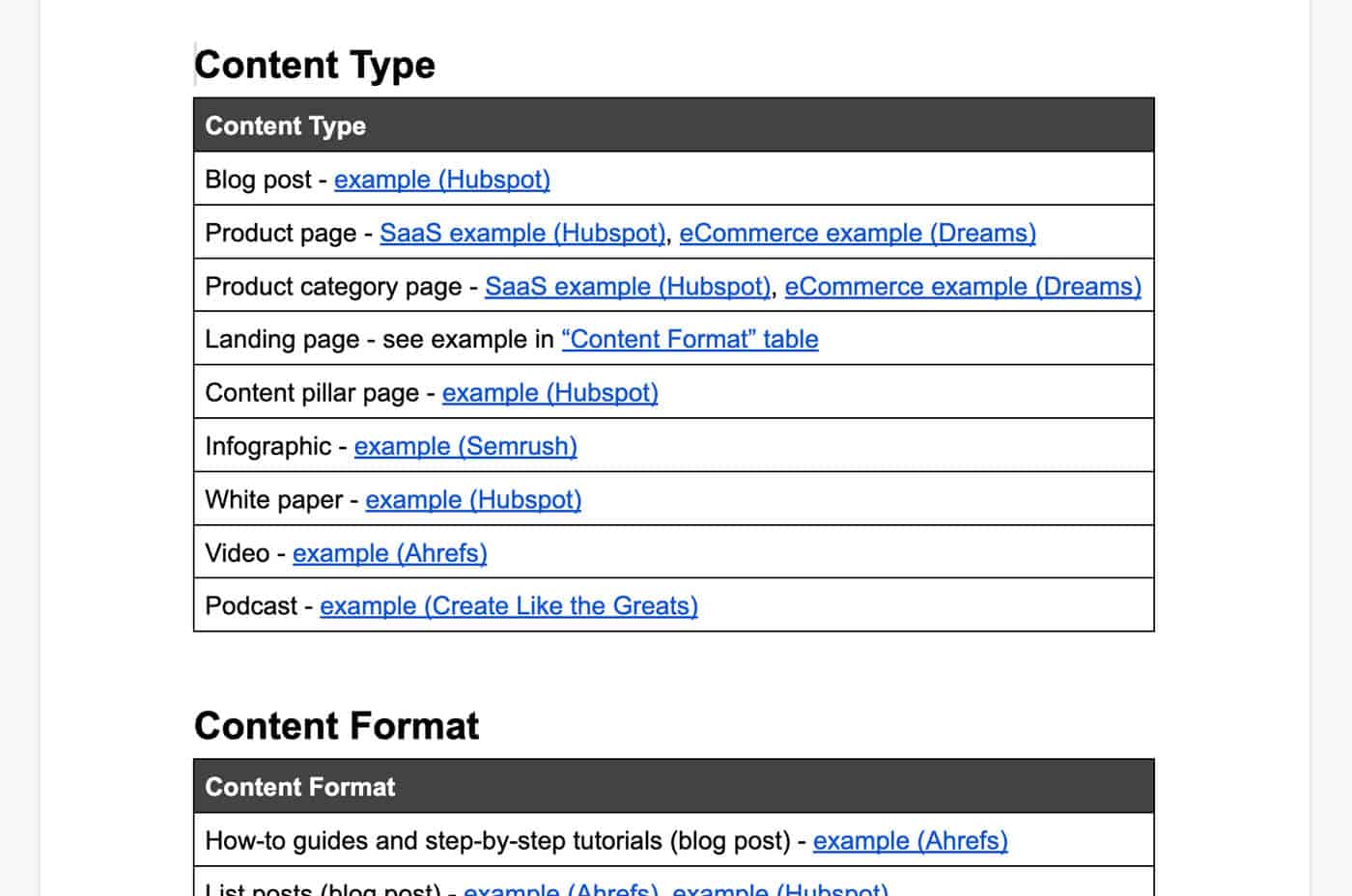
To pick the right combination of the content type, format, and angle – go straight to Google and type in your target keyword.
Take a look at the SERPs and see what content types, formats, and angles other websites are using to address that query. Analyze the top 5 results more closely and start by picking the combination that is the most prominent.
Then try to think whether there is a “hidden” search intent behind the top results, and find a unique angle to showcase your content.
For example, it could be that for a particular topic, all websites just focus on explaining “What is XYZ?” But the user could actually also be searching for “How to Use XYZ?” So, you can come up with an angle that both explains what the topic is and shows how to use it.
4. Come Up With Title Ideas
The next step is to brainstorm and come up with a few different title ideas.
It’s an important part of the content creation process as the title is your chance to capture the attention of your readers and searchers.
Think about the user intent – what words can you use to capture their attention?
Your title should be informative and accurately reflect what the content is about. It should also include the target keyword (ideally, close to the beginning of the title).
For example, when I was coming up with the title ideas for this article, I thought about what sort of questions people might be asking when looking for an article on content outlines.
So, here are some of the title ideas I came up with:
- How to Create Effective Content Outlines (Template & Examples)
- The Ultimate Guide to Creating a Killer Content Outline
- A Step-By-Step Guide to Crafting an Effective Content Outline
- How to Create a Winning Content Outline in 7 Steps
- From Idea to Outline: How to Create an Effective Content Outline
I chose the first one mainly because, in my mind, it fully conveyed the unique selling proposition of the piece (how to create effective content outlines) and described the additional valuable resources a reader can expect to get (template and examples).
Plus, it includes brackets that can draw extra attention and help it stand out in searches.
I suggest you use any of the Generative AI tools for generating unique title ideas, like ChatGPT, Open AI playground, or any of the other tools powered with this technology like Jasper, Copy AI, or Writesonic.
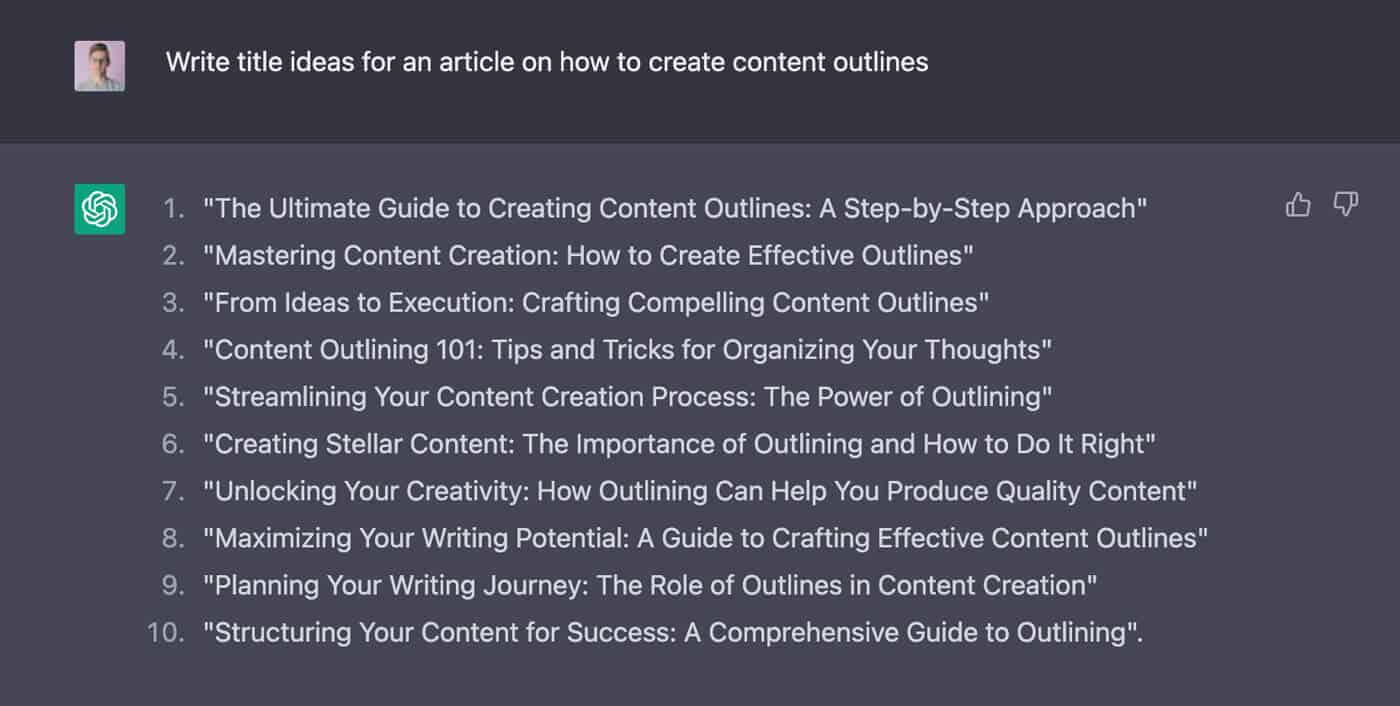
5. Create Headings and Subheadings
Now it’s time for the most important and time-consuming part of the process – actually building out the outline:
- Coming up with headings and subheadings
- Structuring the content logically
- Making sure it covers the topic in full
You will first need to understand what is the baseline for the content on that particular topic and make sure you cover it.
To do this, once again go to Google and start searching for the target query.
Go through the top 5-10 results and make a list of what points they have in common, and make sure you cover those points in your content using headings and subheadings with appropriate tags – like H2, H3, etc.
NOTE
You will notice that there is a lot of overlap, and various pages would explain the same thing in different ways. Your job is to summarize the main ones and come up with an outline that covers the baseline in a concise and logical way.
After you have a list of headings and subheadings for the basic content ready, you will need to research additional points and questions that could be covered with that particular topic.
To find such questions, you can check the “People also ask” box on Google search results for your target query.
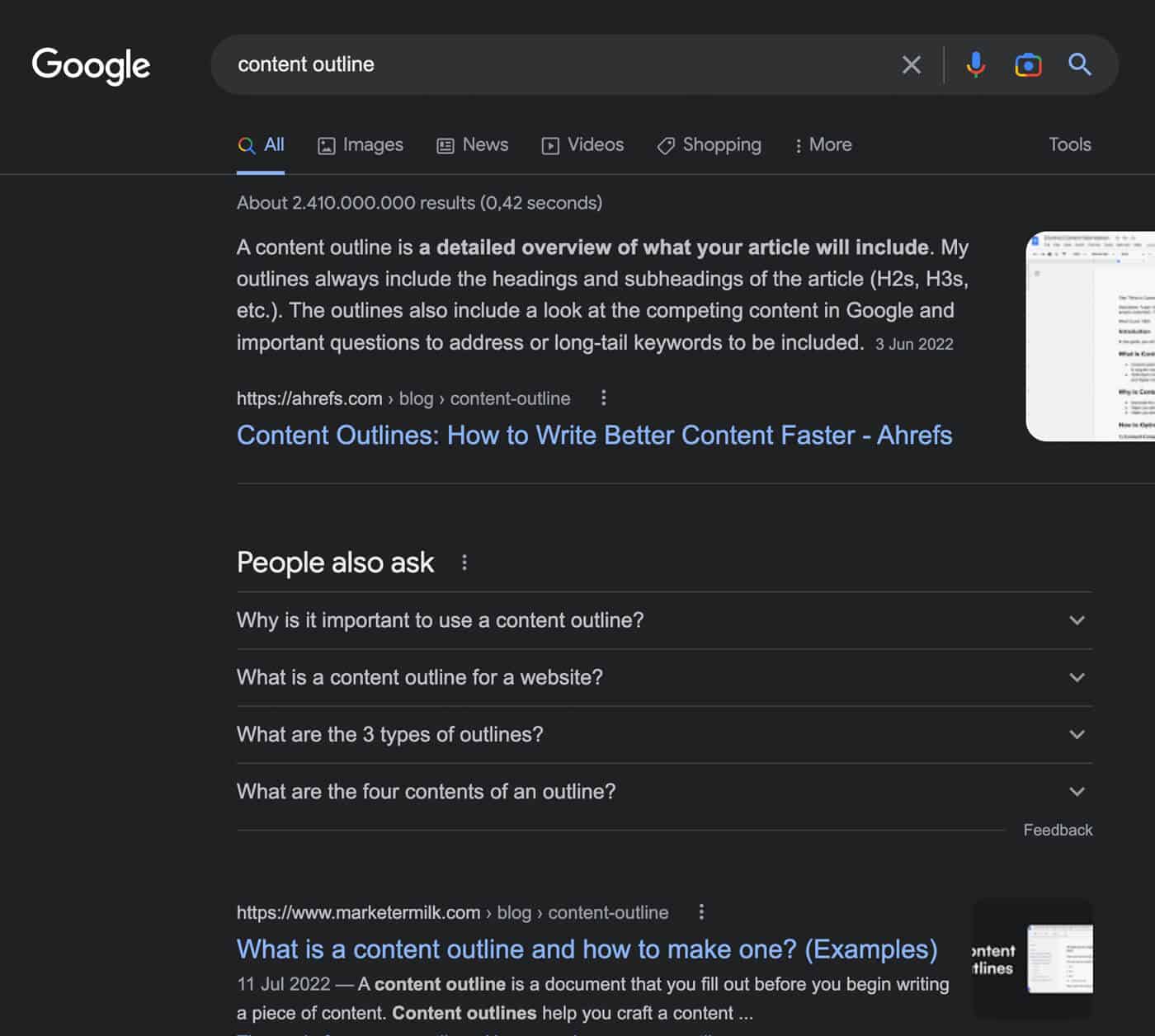
If you click on the question to expand it, additional related questions will appear.
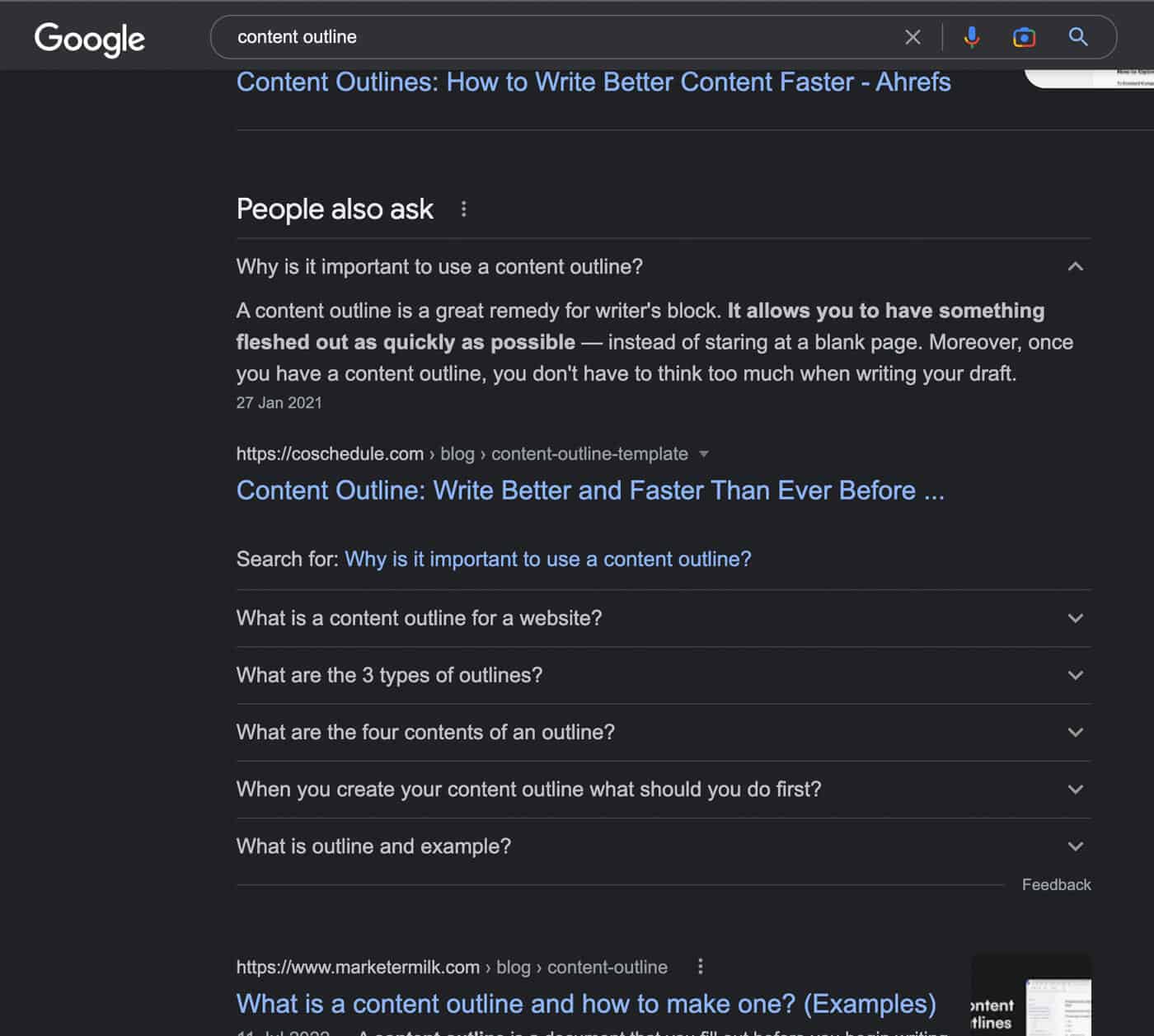
You can keep repeating this process to get more ideas. But be aware that after a few clicks on these questions, the main topic can easily go off in a different direction than what you started with.
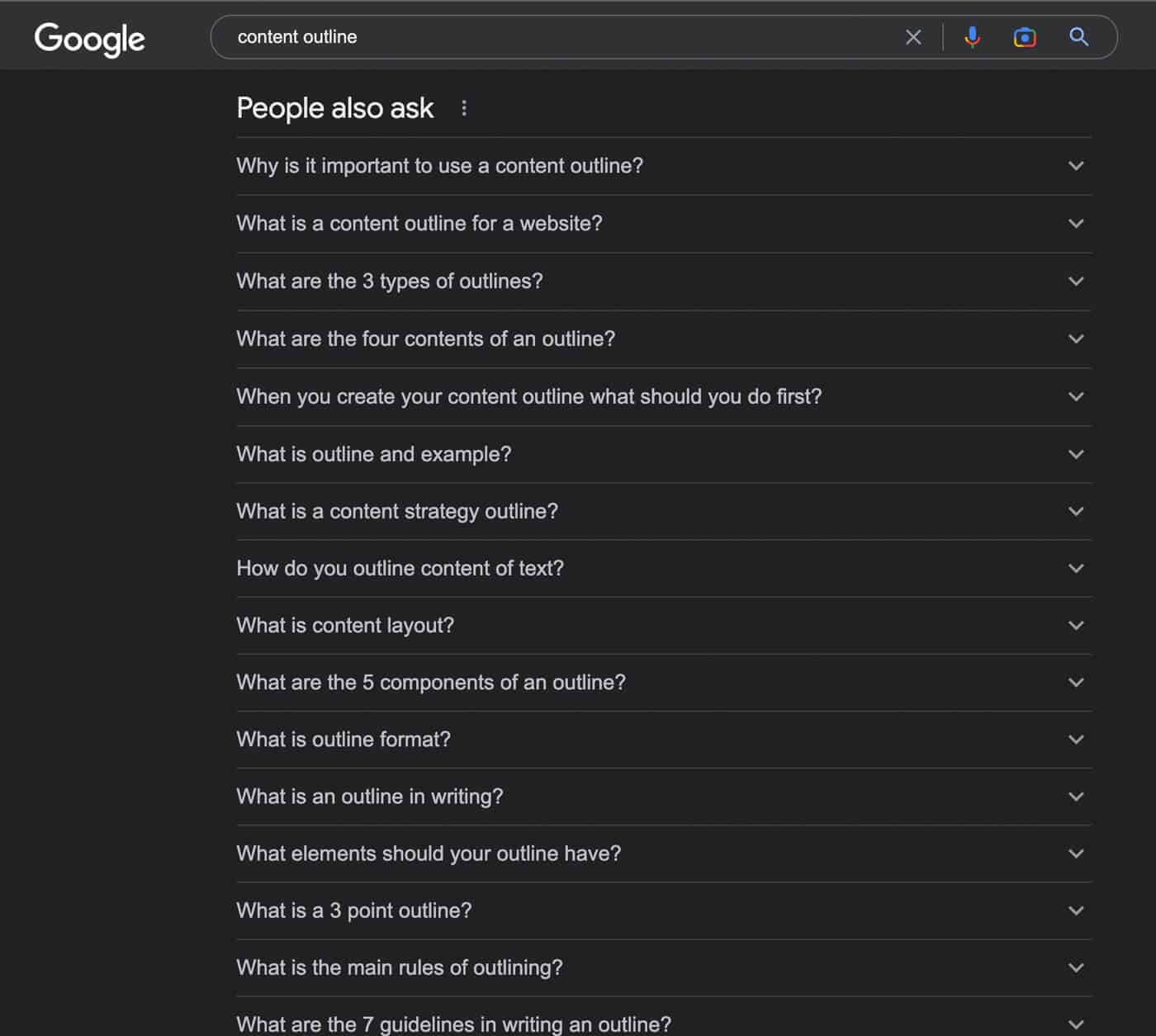
You can also use tools that can help you with gathering ideas from “People also ask”, such as:
- SEO Minion (free Chrome Extension) – to bulk export questions from the “People also ask” box
- AlsoAsked (a freemium tool with 3 searches per month) – for research questions from the “People also ask” box and mapping them out in a visually appealing way
Other great places to find ideas for questions are Quora and Reddit since people usually ask a lot of questions related to the topic.
You can also use AnswerThePublic (a freemium tool with one search per day in a public version and three searches if you create a free account) to get an overview of the most asked questions related to a query.
Furthermore, you can use Google’s autocomplete functionality to get additional ideas. When you start typing a query in the search box, Google will suggest some of the most popular related queries.

Experiment by putting a letter from “A-Z” at the start or the end of your original query and see what Google suggests.
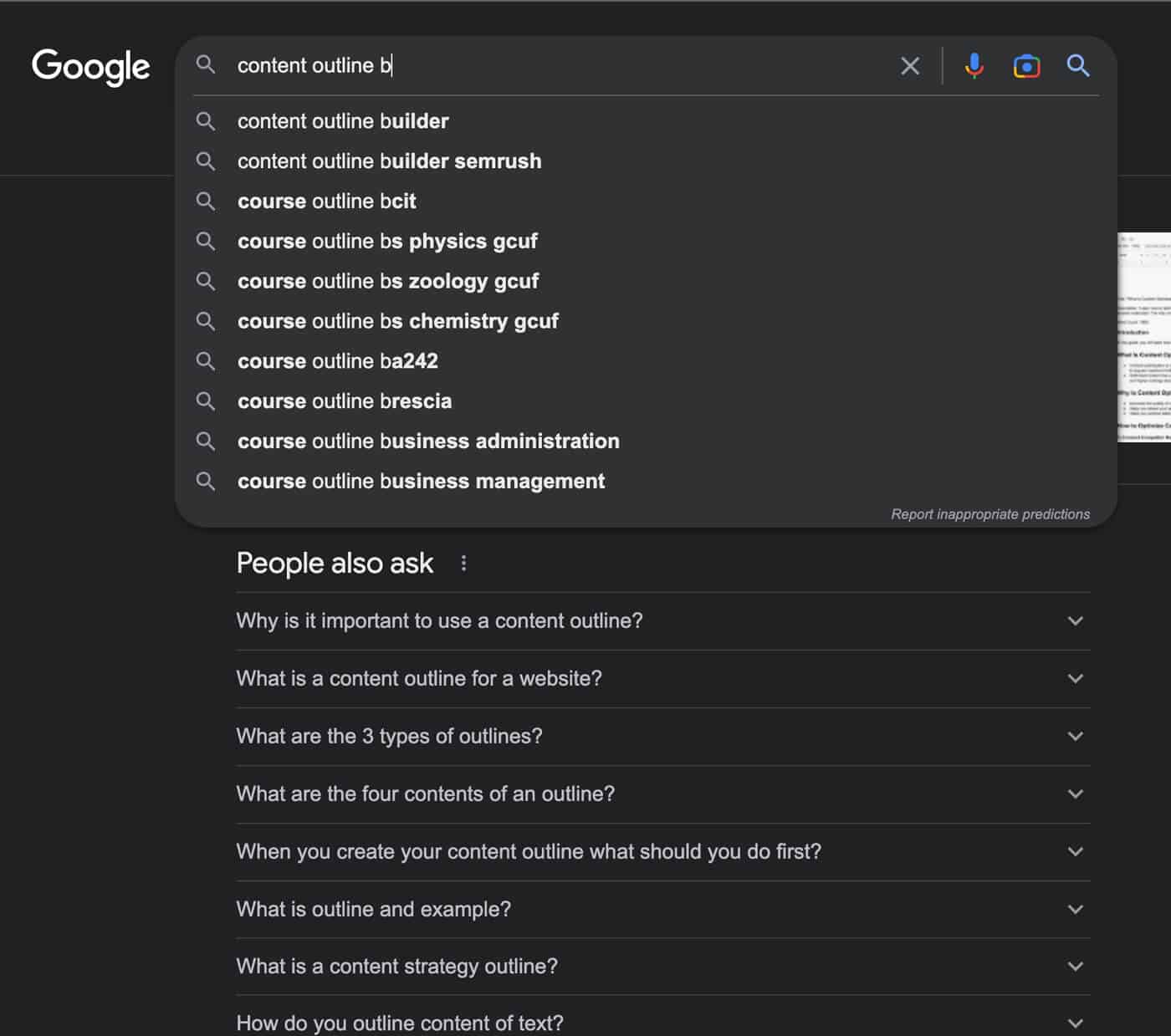
Lastly, you can check at the related searches section at the bottom of the search results page for more ideas.
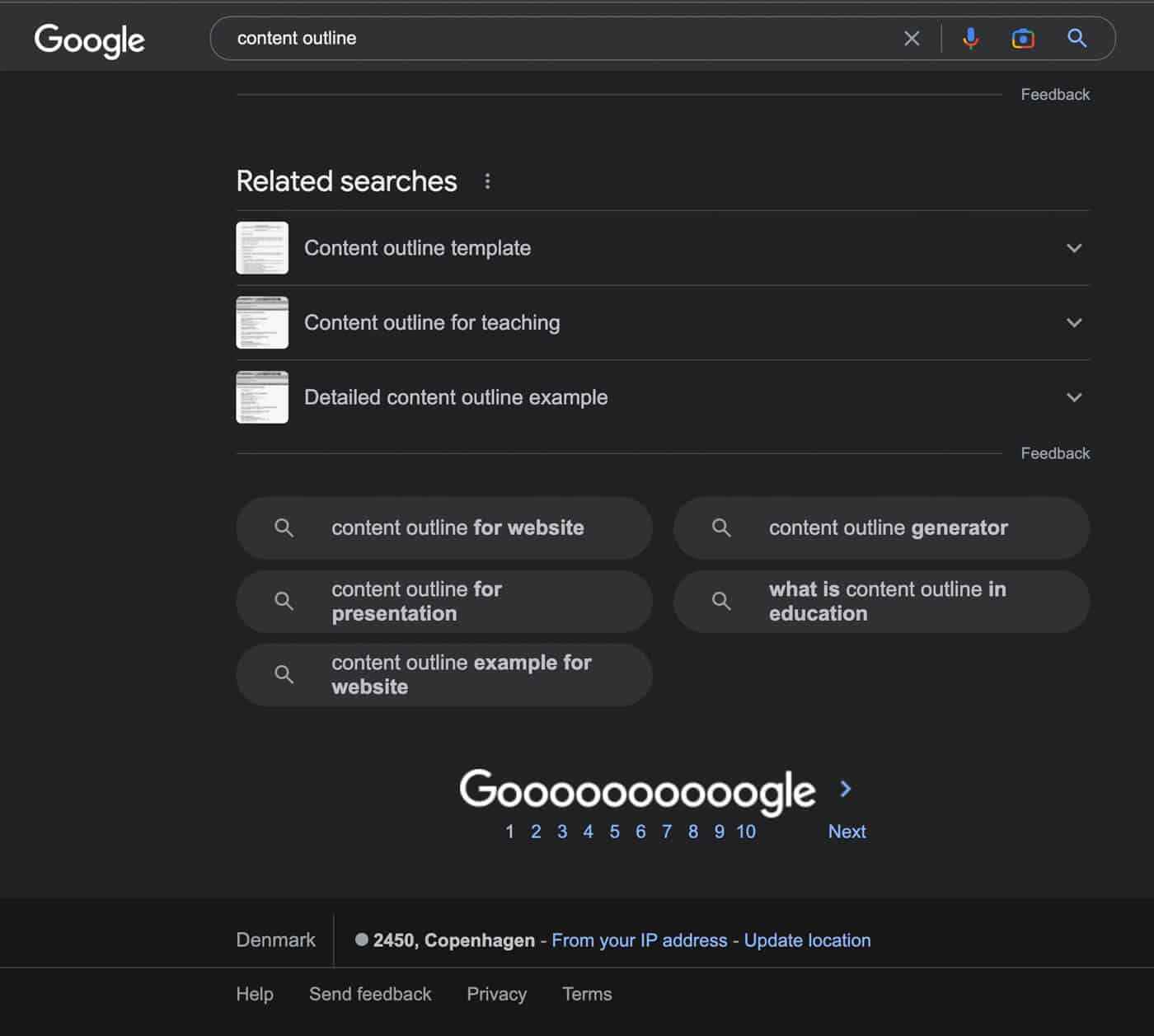
Once you have a list of all the points that are to be covered, as well as all the questions – finalize your content outline by putting everything in a logical structure.
Just like book chapters have sub-chapters, make sure your content follows the same structure, and it is easy for the reader to follow.
NOTE
All the above-mentioned process mainly focuses on the research and idea-gathering part based on what is already out there. Depending on the topic, you might need to include your own thoughts and ideas as well or ask an expert to help. I encourage you to show expertise, present experience, and add your own flavor to the content by adding elements that are unique and make it stand out.
6. Add Supporting Information
Under each heading and subheading you listed down, include any additional supporting information:
- Notes about what to include in this section for more context
- Research results, statistics, and facts
- Quotes from experts or other sources
- Examples and case studies
- Analogies, metaphors, and storytelling
- Links to other related content
- Any visual elements like images, diagrams, illustrations, or videos
- Important keywords to mention
When providing these additional elements, really try to think about how you could make the content more interesting, engaging, and valuable for the reader.
Also, don’t be afraid of making your outlines too comprehensive. This will make it easier for whoever creates the content to get started and have a better idea of how the content should look like. As a result, you will have a higher chance of getting exactly what you imagined.
I have always been creating very detailed content outlines, and I find them really useful for both the person who is writing the content and the one who is overseeing it. None of the writers I worked with ever complained, they actually thanked me for providing such detailed outlines.
7. Include Other Details
Finally, you can also add additional details that would typically be included in full content briefs, such as:
- Deadlines
- Writing and Brand Guidelines
- Goal or Purpose
- CTA (call-to-action)
- Target Audience
- SEO Title, and Meta Description
- Preferred URL
- Target Keywords
- Word Count
- Internal Links
- External Sources
- Visuals
- Competitor Examples
- Etc.
Curious to learn more about content briefs? Check out the guide on how to create an effective content brief!
Using a Content Outline Template
If you want to take the content outlining process a step further, I have created a template that can help you get started.
This template provides a basic structure that you can follow and fill in the details accordingly.
You can make a copy of it here: make a copy.
Examples of Content Outlines
Here are three examples of content outlines that I have created when creating blog articles for my website.
Content Outline Example 1 (outline for this article that you are reading):
You can make a copy of it here.
Content Outline Example 2 (outline for the article about how to write a content brief):
You can make a copy of it here.
Content Outline Example 3 (outline for the article about SEO-focused content briefs):
You can make a copy of it here.
Also, check out the post on content brief examples to also see what a real content brief could look like.
Streamline Work With Content Outlines
Creating effective content outlines is a great way to facilitate the content creation process.
Having everything properly organized and listed down will make it easier for everyone involved in the content creation process to collaborate and get the job done. Moreover, it provides great insight into the content before it is even written, saving time and energy that could have been otherwise wasted.
Streamline your next content project with an effective content outline, and you will be happy you did!
I have provided free content outline template to get you started – feel free to make a copy of it here.
